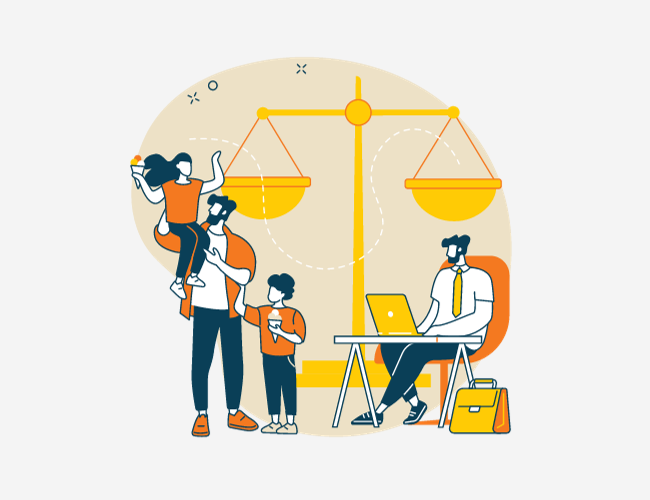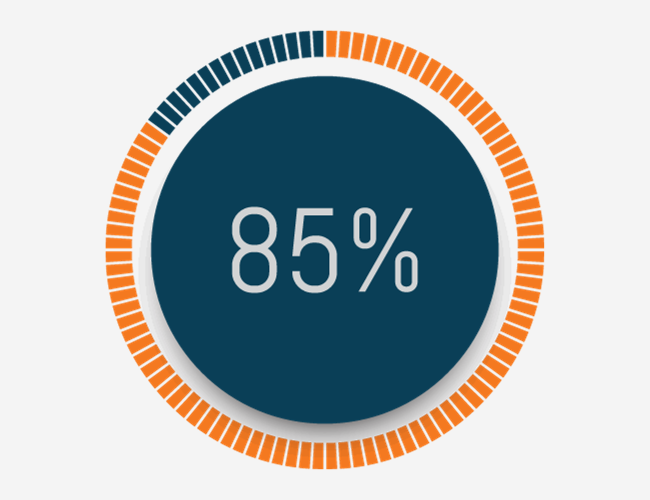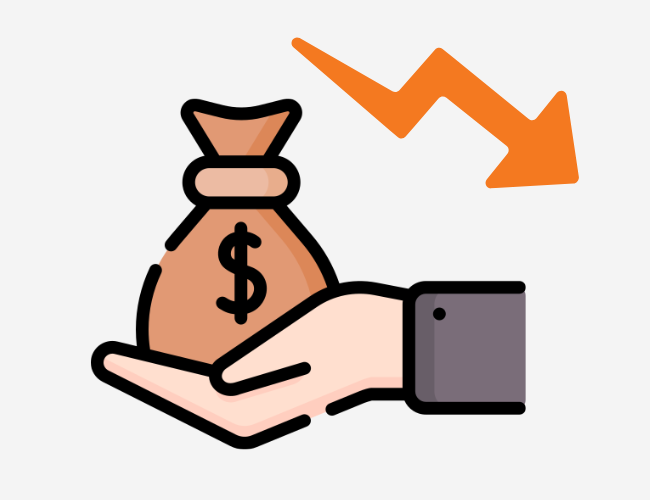Whether reading this on Labor Day or any other day, acknowledging the contributions of the workforce serves as a reminder of both their productive efforts and the pervasive challenges they face. Nearly three-quarters of employees are battling burnout. With efficiency and progress coming at the expense of personal well-being, the prevalence of burnout serves as an urgent call to examine the root causes and explore innovative solutions.
Ringover, a global telecom company, recently surveyed more than 1,000 US-based employees about their experiences with burnout. This article covers the findings from the survey, explores traditional employer solutions, and offers new, creative approaches to tackle the issue head-on.
Pressed for time? Here’s a quick summary…
- Prevalence & causes of burnout: Burnout affects three in four workers in the US, primarily driven by heavy workloads, lack of resources, micromanagement, and toxic work environments.
- Conventional solutions that fall short: One-size-fits-all educational workshops and surface-level perks fail to address the core issues that contribute to burnout.
- Effective burnout mitigation strategies: To effectively address burnout, employers must promote work-life balance, transparent communication, continuous growth, and empowerment in the workplace. This includes tailoring work arrangements to suit individual preferences, offering generous PTO and mandatory time off, and establishing anonymous feedback platforms, among a range of other potential measures.
The Latest Findings From Ringover
Burnout is a condition characterized by chronic physical and emotional fatigue, a diminished sense of accomplishment, and a loss of personal identity, often resulting from prolonged exposure to workplace stressors.
Ringover’s recent survey reveals that nearly three in four workers experience burnout and related symptoms. The leading causes of work-related burnout include:
- Heavy workloads (43.0%)
- Lack of resources (36.9%)
- Micromanagement (36.6%)
- Toxic work environments (34.5%)
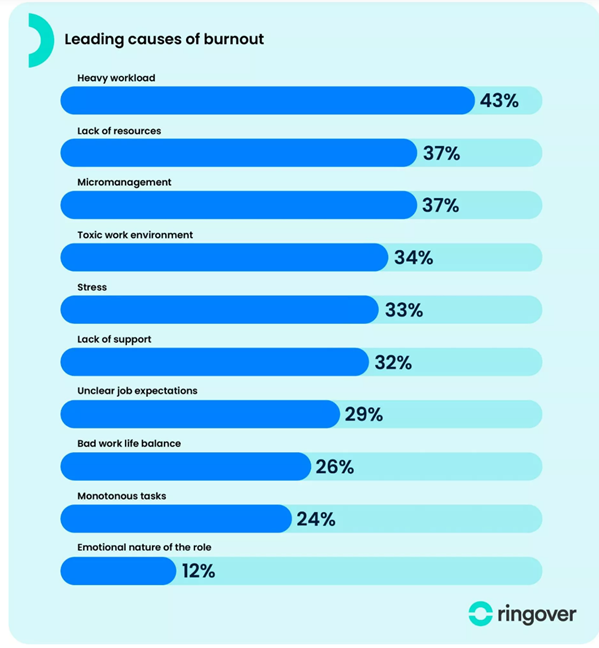
These factors suggest that burnout is often not an individual issue but a systemic one. Addressing it may require significant organizational change, not just personal time management or stress relief techniques. The causes also point toward the critical role that management plays in employee well-being. Effective managers can alleviate these stressors by redistributing workloads, ensuring adequate resources, and fostering autonomy.
The leading symptoms of burnout include:
- Persistent exhaustion (42.8%)
- Feeling detached (32.6%)
- Feeling helpless, trapped, or defeated (31.7%)
- Having a pessimistic outlook (27.4%)
- Self-doubt (27%)
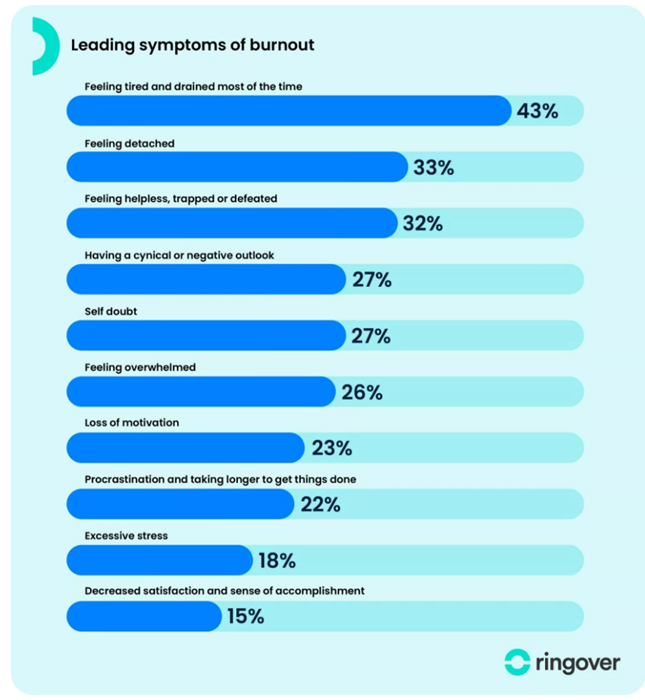
These symptoms, tied to fundamental psychological needs like well-being (exhaustion), belonging (feeling detached), and efficacy (feeling helpless) severely impact job performance but often go unnoticed, leading to a downward spiral that affects both the employee and the organization.
Burnout Demographics
Burnout is a widespread phenomenon, impacting various ages, genders, and industries.
Gender Differences
- Over two-thirds of male workers consider changing roles due to burnout.
- While women are less likely to take action following burnout, 59% still consider a job switch.
This hints at the universality of burnout’s impact while raising questions about potential disparities in speaking up about it. Research suggests that women may be less likely to speak up due to a variety of factors, including concerns about repercussions, societal expectations, or workplace dynamics.
Industry Findings
- The industries with the highest levels of burnout include:
- Agriculture (84.38%)
- Financial activities and insurance (82.4%)
- Information publishing and telecommunications (81.38%)
- Public sector (80.49%)
The prevalence of burnout in these sectors underscores the need for tailored solutions within these fields, where stressors may be distinctive and intensify burnout.
Age Insights
- 85% of workers between the ages of 18-24 are impacted by burnout, representing the most prominent age group affected.
- Over half of employees aged 55-64 experience burnout, but many are uncomfortable discussing stressors at work.
The hesitation to discuss stressors among older generations may be attributed to traditional workplace cultures, where speaking up about well-being may not have been encouraged or was seen as a sign of weakness.
Conventional Solutions That Fall Short
Employers have rolled out a variety of initiatives to address the rise in workplace burnout. While they have good intentions, traditional approaches may miss the mark, failing to tackle the root causes and symptoms of burnout.
One-Size-Fits-All Workshops
Workshops focused on time management, stress relief, or resilience can be useful, but have limited impact without substantial systemic changes. Teaching breathing techniques may provide temporary stress-relief, but it’s not a long-term solution for dealing with toxic co-workers or an ongoing influx of late-night work emails.
- Potential Alternative: Conduct employee-specific stress assessments to tailor interventions to individual needs.
Surface-Level Perks
Similarly, perks like gym memberships or catered lunches can remain superficial if they skirt around core issues such as heavy workloads, lack of autonomy, or a toxic work culture. Providing a gourmet snack bar might seem appealing, but if employees are facing unrealistic deadlines and heavy workloads, snacks do little to address the root problems.
- Potential Alternative: Offer flexible work hours or remote work options to reduce daily stressors related to commuting or work-life balance.
Top-Down Communication
Mandating wellness initiatives without encouraging employees to share feedback, voice concerns, or contribute to solutions can create resistance and hinder progress. For example, a wellness program centered around lunchtime yoga sessions can lack inclusivity and personalization. Without two-way communication, employees may feel their needs and preferences are being ignored.
- Potential Alternative: Implement anonymous suggestion boxes or regular feedback surveys for employees to voice their needs.
Blanket Policies
Instituting policies without considering the nuances of unique teams and roles can result in inefficiencies and additional stressors. Consider a uniform remote work policy: while its flexibility might be a perk for some, it could unintentionally burden roles that require more in-person collaboration.
- Potential Alternative: Adopt a “team-specific” approach to policies, recognizing the unique dynamics and requirements of different departments.
Rigid 9-5 Expectations
Strict adherence to a 9-to-5 schedule neglects the diverse needs and preferences of roles and individuals, which can be counterproductive and stressful. Some employees might excel during hours outside typical work hours or choose to work longer with intermittent breaks dispersed throughout the day.
- Potential Alternative: Implement flextime policies that allow employees to work during their most productive hours.
Open Office Layouts
Although designed for collaboration, open office layouts can inadvertently increase stress for employees who require quiet and privacy to function optimally. An introverted employee struggling to concentrate in a bustling open office may find their stress levels heightened due to noise and lack of privacy.
- Potential Alternative: Provide quiet zones or soundproof booths for focused work.
Mandatory Team-Building Events
Implementing “mandatory fun” events may aim to enhance social wellness, but if these events encroach on personal time or trigger anxiety, they can breed resentment. Employees who prioritize personal downtime for rejuvenation may find forced social or team-bonding activities burdensome, feeling a lack of autonomy in choosing how and when they unwind.
- Potential Alternative: Offer opt-in wellness activities that cater to various interests, allowing autonomy in how employees choose to unwind.
Annual Performance Reviews
Relying on infrequent annual performance reviews denies employees regular feedback and clear expectations, prolonging periods of uncertainty and stress. An employee lacking consistent guidance might feel anxious during the months leading up to their annual review.
- Potential Alternative: Adopt regular one-on-one check-ins for more immediate and ongoing feedback.
Glorification Of Overworking
Praising employees for pulling all-nighters or working during weekends can create a “hustle culture”, boosting burnout and tolling employee well-being. This undermines work-life balance, promotes unsustainable behaviors, and can diminish trust and job satisfaction.
- Potential Alternative: Recognize and reward efficiency and productivity, rather than just time spent on tasks.
Excessive Competition
While competition can drive achievements, an overemphasis on rivalry can cultivate a toxic work culture detrimental to well-being. Healthy competition becomes unhealthy when team members are excessively pushed to outperform each other, despite an initial spike in motivation. This can breed resentment and negatively impact mental health.
- Potential Alternative: Promote collaborative goals and team-based rewards to foster a more cooperative environment.
Vacation Constraints
Encouraging all employees to take their vacations in one long chunk doesn’t accommodate diverse rejuvenation preferences, limiting the efficacy of time off. An annual leave in a single block might not benefit someone who enjoys shorter, regular breaks throughout the year.
- Potential Alternative: Introduce a “flexible vacation” policy that allows for shorter, more frequent breaks to accommodate diverse rejuvenation preferences.
15 Innovative Employee Burnout Solutions
Organizations must explore new employee burnout strategies to ensure that employees have comprehensive resources for good mental health. These creative solutions can effectively mitigate work-related stress and foster a healthier, engaged workforce.
1. Flexible Work Hours & Remote Work
Empowering employees with autonomy over their work arrangements optimizes performance and contributes to work-life balance. Consider these scenarios:
- Flextime: A night owl, whose energy spikes later in the day, can harness peak productivity hours by shifting their work hours.
- Four-Day Workweek: A working parent can leverage a four-day workweek to maximize free time with family.
- 44% of survey respondents said a four-day workweek would positively affect their happiness levels in their role.
- Remote Work: An employee whose tasks require high levels of independence could work from the comfort of their home to minimize distractions from an open office layout.
- More than one-third of survey respondents said remote work would elevate their happiness levels in their current roles.
Taking a one-size-fits all approach to work arrangements disregards the unique needs and preferences of individuals, hindering both productivity and well-being. Flexibility and autonomy minimize stress and commuting fatigue, mitigating burnout among employees.
🔑 Key Insight: Flexibility enhances both productivity and well-being, turning work-life balance into work-life synergy.
👟 Next Step: Try a month-long ‘Flex Experiment’—employees can choose their preferred work hours and evaluate their productivity and well-being after 30 days.
2. Unlimited PTO
Embracing unlimited PTO allows employees to take time off when needed, reinforcing ownership over their workload. This doesn’t turn the office into a ghost town: employees with unlimited PTO take similar or fewer vacation days than those with traditional PTO arrangements. When quality of work replaces time as a measure of success, employees are less likely to experience burnout.
🔑 Key Insight: Empowering employees with unlimited PTO shifts the focus from time to quality, alleviating burnout symptoms.
👟 Next Step: Introduce a ‘Staycation Bonus’—financial incentives for employees who take time off but stay local, supporting local businesses.
3. Mandatory Time Off
Instituting mandatory breaks, like “no work” hours or “mandatory minimums” for days off, ensures consistent rest and rejuvenation. Goldman Sachs, for example, requires all employees to take at least three weeks of vacation every year. Mandatory breaks create a positive and supportive work environment where employees feel encouraged to prioritize their well-being.
🔑 Key Insight: Mandatory breaks disrupt the cycle of burnout by making rest an integral part of the work culture.
👟 Next Step: Implement ‘Silent Saturdays’—where no work-related emails or messages can be sent, encouraging true time off.
4. Learning & Development
Providing opportunities for employees to learn new skills beyond their immediate role enriches their professional journey. From a graphic designer acquiring coding tactics to a sales representative learning the ins and outs of social media, diverse experiences break the monotony and reignite passion.
🔑 Key Insight: Skill diversification revives employee enthusiasm and breaks the monotony of everyday tasks.
👟 Next Step: Host a quarterly ‘Skills Swap’ workshop where employees can teach and learn from each other.
5. Sabbaticals
Offering long-term employees the opportunity to take a sabbatical allows them to reset for personal growth. A sabbatical could be used for anything from exploring a passion project to traveling the world, returning with fresh enthusiasm and insights.
🔑 Key Insight: Sabbaticals provide a long-term solution for burnout by allowing comprehensive personal and professional growth.
👟 Next Step: Create a ‘Sabbatical Proposal Program’ where employees can outline the potential benefits of their time off.
6. No Meeting Days
The constant influx of meetings can disrupt employees’ flow and limit their ability to engage deeply with their tasks. This is particularly relevant for remote workers who may experience “Zoom fatigue” and employees whose responsibilities demand deep, uninterrupted focus. Allocating “No Meeting Days” can prevent burnout by promoting a more sustainable rhythm that balances individual work with collaboration.
🔑 Key Insight: No Meeting Days relieve mental congestion and offer space for uninterrupted focus.
👟 Next Step: Designate the last Thursday of every month as a ‘Deep Work Day’ with no meetings allowed.
7. Employee Well-Being Programs
Investing in a holistic wellness program nurtures every dimension of employees’ health. From step challenges to mindfulness workshops, a comprehensive program cultivates a healthier, happier workforce. These initiatives recognize that employee well-being extends beyond the office, preventing burnout and increasing employee engagement and resilience.
🔑 Key Insight: Holistic well-being programs cultivate a resilient workforce by taking care of employees’ physical and mental health.
👟 Next Step: Introduce a ‘Monthly Mindfulness Challenge’—employees practice mindfulness and share their experiences.
8. Job Rotation
Allowing employees to rotate roles or departments not only adds variety but also offers a fresh perspective on company operations. For instance, a marketing specialist trying their hand at customer service can break away from routine while gaining insights that contribute to a more interconnected workforce.
🔑 Key Insight: Job rotation reinvigorates employees and provides them with a broader perspective on company operations.
👟 Next Step: Establish a ‘Rotation Month’ where interested employees can sign up to shadow or switch roles.
9. Employee Assistance Programs (EAP)
Offering Employee Assistance Programs (EAPs) reinforces a supportive work environment that guides workers through personal and professional challenges. EAPs provide resources and a safe space for employees to address their difficulties, including burnout-inducing stressors. By accessing the help they need, employees can enhance their well-being and, in turn, their overall job satisfaction and performance.
🔑 Key Insight: EAPs offer a lifeline to employees, allowing them to navigate personal and professional challenges.
👟 Next Step: Promote your EAP actively during high-stress periods like quarter-end, so employees remember it’s available.
10. Feedback Platforms & Open Communication
Leveraging platforms for anonymous employee feedback empowers workers to voice concerns without fear of repercussions. This two-way communication can help employers identify and tackle potential burnout triggers. Additionally, an “open door policy” in which employees are encouraged to share concerns with their manager at any time reinforces a culture of open communication and proactivity.
🔑 Key Insight: Anonymity fosters honesty, helping to identify latent issues before they lead to burnout.
👟 Next Step: Use a real-time feedback app to gauge employee sentiment on new initiatives or after busy seasons.
11. Break Spaces
Designating break spaces or wellness rooms offers an area where employees can escape from the hustle of the office to prioritize their well-being. Whether it’s a power nap room or a fitness center, these spaces can mitigate burnout by granting employees the opportunity to take regular breaks for rejuvenation.
🔑 Key Insight: Designated wellness spaces facilitate physical and mental breaks, reducing continuous work stress.
👟 Next Step: Invite employees to co-create a ‘Zen Zone’ in the office, using plants, art, and other calming elements.
12. In-House Counselors
Employing full-time counselors or therapists on-site offers a confidential resource for employees to consult when they’re feeling overwhelmed by personal and professional stressors. This confidential outlet can address strains in the workplace, promoting a culture that prioritizes mental well-being and resilience.
🔑 Key Insight: On-site counselors provide immediate, confidential mental health support, which is crucial in preventing burnout.
👟 Next Step: Host a ‘Meet the Counselor’ coffee morning for employees to familiarize themselves with this resource.
13. Chief Wellness Officer
Appointing a Chief Wellness Officer can be a game-changer for enhancing the overall well-being of the workforce. By having a position dedicated to spearheading initiatives spanning mental, physical, and emotional wellness, the officer can play a pivotal role in burnout prevention.
Kristine Olson, Chief Wellness Officer at Yale New Haven Hospital, underscores the gravity of hospital well-being concerns, with:
- 63% of physicians experiencing burnout in 2021, a significant surge from 38.2% in 2020.
- Two out of three nurses (67%) intending to leave their position within 3 years as of 2020.
Olson emphasizes the value a Chief Wellness Officer can bring:
“A chief wellness officer can help you to identify where those areas of difficulties are. And it can also point the way to improving that. And looking at those metrics can help you identify ways to become a more efficient and high performing healthcare organization, through the lens of your professionals who can point the way to those opportunities.”
🔑 Key Insight: A dedicated role for wellness ensures a strategic, company-wide approach to burnout prevention.
👟 Next Step: Run a ‘Wellness AMA (Ask Me Anything)’ session with the Chief Wellness Officer every quarter.
14. Limit Overtime
Companies should ensure that employees adhere to their scheduled number of hours to maintain work-life boundaries. While overtime might be worn as a badge of honor, its true impact lies in escalating stress and fatigue. Monitoring and restricting overtime underscores a commitment to employee well-being and develops a sustainable work culture.
🔑 Key Insight: Restricting overtime enforces work-life boundaries and prevents employee burnout.
👟 Next Step: Implement a ‘Log-Off Reminder’ that prompts employees to end their workday after a certain hour.
15. Regular Check-Ins
Rather than waiting for an annual performance review, conducting regular check-ins between managers and team members fosters open dialogues about workload, challenges, and mental well-being. These consistent interactions allow employees to voice concerns and receive guidance, facilitating early intervention for potential burnout triggers.
🔑 Key Insight: Frequent dialogue allows for immediate adjustments and interventions, reducing the lag time in addressing issues.
👟 Next Step: Establish ‘Weekly Pulse Checks,’ quick 15-minute check-ins to discuss workloads, challenges, and well-being.








